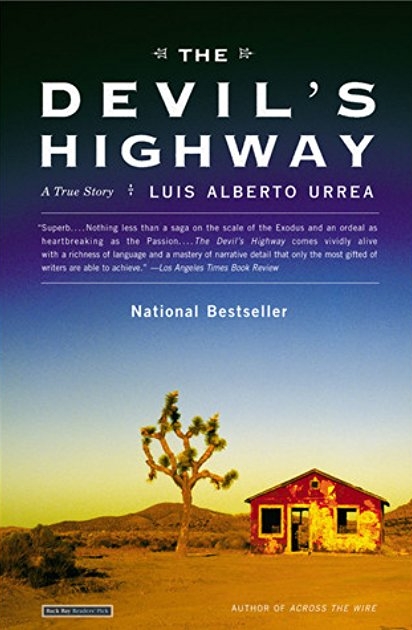Faculty Picks: Urrea, Luisella, Lacy, Ward
Mark Sundeen-- With each day's news force-feeding us another rotten plum, my appetite for diversionary arts has waned. What’s the point of writing in this moment if you’re not grappling with the white supremacy that has crawled out of its hole, onto the streets, and into the oval office? This month I’ve read and assigned two books that confront the way this country treats people of color as less than human.
The Devil’s Highway by Luis Alberto Urrea recounts the horror of Mexican migrants led to their death in the furnace of the Arizona desert, after the easier routes to El Paso and San Diego were blocked by walls. This militarization of a friendly border is largely caused by the narcotics trade, which of course exists to serve its American customers.
Tell Me How it Ends: An Essay in 40 Questions by Valeria Luissella navigates the legal labyrinth that holds Central American children, refugees from the gang wars that can be traced back to US military ops in El Salvador and Honduras during the Reagan years.
The border is deeply complex, and racism is not its only evil. But if these aspiring Americans were blonde Canadians they would not languish in court or die beneath a mesquite shrub.
Lisa Janicki-- Much has been written in recent years about our unruly expectations for lifelong romance: how can just one partner/lover/co-parent fulfill our every desire? It seems we’ve become unreasonable, and we’re therefore never satisfied. Enter the premise of Catherine Lacey’s novel, The Answers, a story about the Girlfriend Experiment, wherein a research team hires a lineup of women to satisfy the various needs of Kurt Sky, an actor/filmmaker/asshole whose life of fame has (according to him) made it impossible for him to experience love. The Intimacy Girlfriend sleeps with Kurt, the Anger Girlfriend hurls dishes at him, the Maternal Girlfriend comforts him and wears linen. Mary, the protagonist, is hired as the Emotional Girlfriend, which requires her to be loving and attentive without presenting a distracting amount of her own personhood. If the premise makes you cringe, I get it; I cringed too. But it’s Catherine Lacey, and I’d follow her anywhere.
The Answers is a powerful and gorgeous meditation on the compartmentalization of self. While serving as Emotional Girlfriend, Mary also undergoes experimental new agey treatments for a lifetime of physical ailments and psychic bruises. It’s a novel about love, but also about the curious way illness intimately acquaints us to our bodies, even as it alienates us from them. Lacey frolics in the interplay between the corporeal and the psychological: “her skull felt like it might shatter in her head (and what is anyone’s head but a history, a house for all your history).” She gives us a book that rattles heart, mind and bones.
Robin Wasserman-- I can't stop reading the news. I mean can't in the sense of compulsion, the sickening inability to look away. But I also mean it as an injunction, a reminder that I can't stop, no matter how much I might want to. I mean I can't – cannot, but also must not – look away.
It's not the job of fiction to report current events. But maybe it is the work of fiction to report current events; to say, this, now, is the world and its people. This is the feeling of someone else's pain. Don't look away.
This is what Jessmyn Ward’s Salvage the Bones demands of its reader: an unflinching gaze. Look at fifteen-year-old Esch, poor and pregnant and desperate for someone to love. Look at her brothers, each clinging to his own strategy for surviving a hard life in the Mississippi bayou. Look at the fierce devotion binding them together. Look, hard, at the storm that will tear their home and their lives apart, “the flailing wind that lashes like an extension cord used as a beating belt,” “the rain, which stings like stones, which drives into our eyes and bids them shut... trees and branches breaking, popping like Black Cat firecrackers in an endless crackle of explosions, over and over and again and again.”
I don’t know whether this is the best time or the worst time to read a novel about a hurricane, but it turned out to be the right time.
“And everywhere there are people, looking half drowned; an old white man and an old black man camping out under a tarp spread under a lone sapling; a family of Vietnamese with sheets shaped into a tent over the iron towing bar used for mobile homes, plywood set under the draping to make a floor; teenage girls and women foraging in the parking lot and hollow shell of a gas station, hunting the wreckage for something to eat, something to save. People stand in clusters at what used to be intersections, the street signs vanished, all they own in a plastic bag at their feet, waiting for someone to pick them up. No one is coming.”
Don't look away: https://hispanicfederation.org/unidos/




